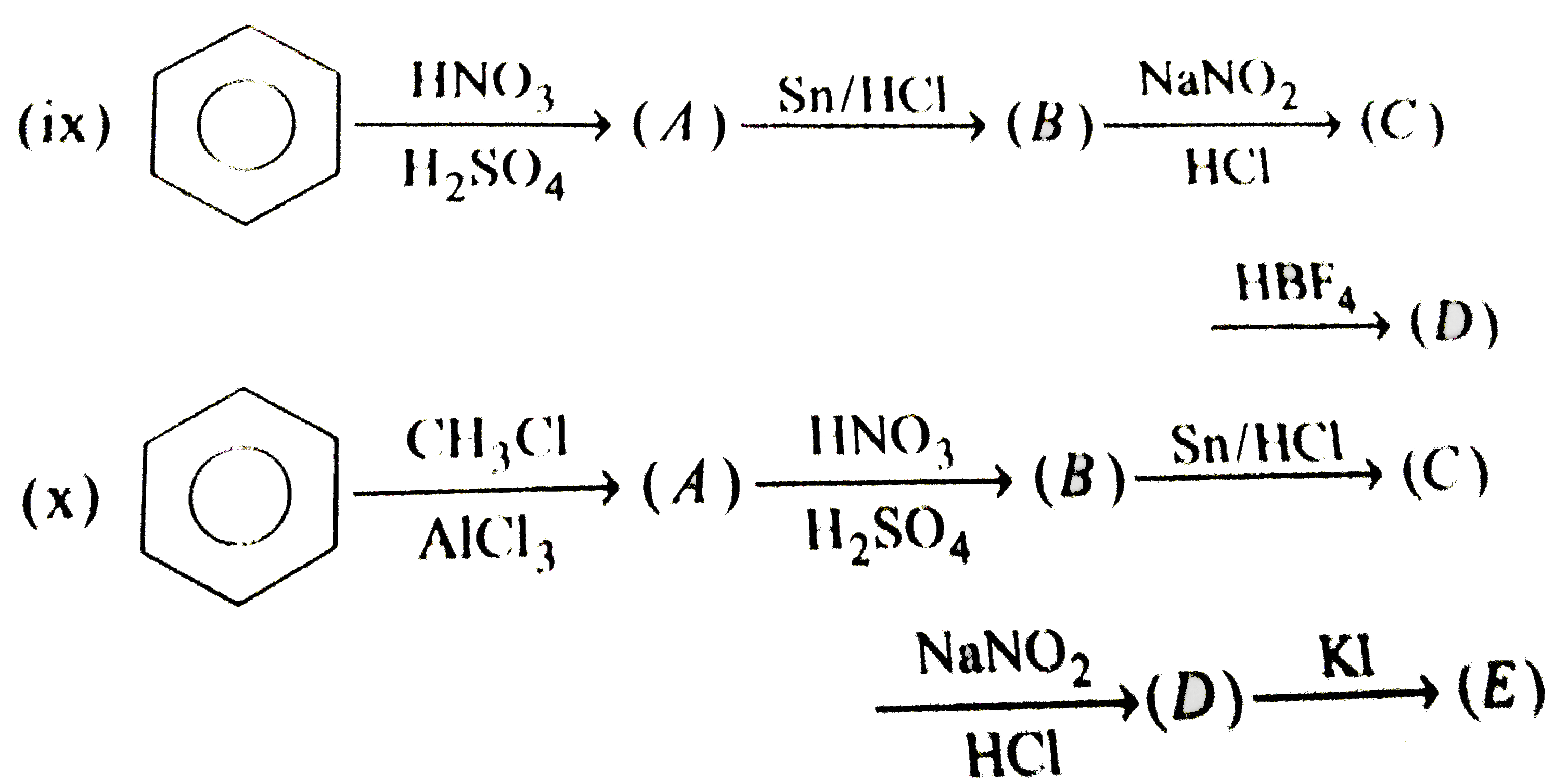Identify the products (A), (B) and ('C').
C2H4HBr−−→(A)Hydrolysis−−−−−→(B)Na2CO3−−−−→I2(C)
To solve the problem step by step, we will identify the products A, B, and C based on the given reactions.
Step 1: Reaction of Ethylene (C2H4) with HBr
The first step involves the addition of HBr to ethylene (C2H4). Ethylene is a symmetrical alkene, and when HBr is added, the product will be:
C2H4+HBr→C2H5Br
Here, the product A is bromoethane (C2H5Br).
Step 2: Hydrolysis of Bromoethane (A)
Next, we perform hydrolysis on bromoethane (A). In this reaction, water (H2O) acts as a nucleophile and attacks the carbon atom bonded to the bromine atom, resulting in the substitution of the bromine atom with a hydroxyl group (OH):
C2H5Br+H2O→C2H5OH+HBr
The product B is ethanol (C2H5OH).
Step 3: Reaction of Ethanol (B) with Iodine (I2) and Sodium Bicarbonate (Na2CO3)
In the next step, ethanol (B) reacts with iodine (I2) in the presence of sodium bicarbonate (Na2CO3). This reaction is known as the iodoform reaction, which occurs because ethanol can be oxidized to acetaldehyde (CH3CHO), and then reacts with iodine to form iodoform (CHI3):
1. Oxidation of ethanol to acetaldehyde:
C2H5OH→CH3CHO
2. Iodoform reaction:
CH3CHO+I2+Na2CO3→CHI3+by-products
The product C is iodoform (CHI3).
Summary of Products
- Product A: Bromoethane (C2H5Br)
- Product B: Ethanol (C2H5OH)
- Product C: Iodoform (CHI3)
The first step involves the addition of HBr to ethylene (C2H4). Ethylene is a symmetrical alkene, and when HBr is added, the product will be:
Next, we perform hydrolysis on bromoethane (A). In this reaction, water (H2O) acts as a nucleophile and attacks the carbon atom bonded to the bromine atom, resulting in the substitution of the bromine atom with a hydroxyl group (OH):
In the next step, ethanol (B) reacts with iodine (I2) in the presence of sodium bicarbonate (Na2CO3). This reaction is known as the iodoform reaction, which occurs because ethanol can be oxidized to acetaldehyde (CH3CHO), and then reacts with iodine to form iodoform (CHI3):
C2H5OH→CH3CHO
CH3CHO+I2+Na2CO3→CHI3+by-products
- Product A: Bromoethane (C2H5Br)
- Product B: Ethanol (C2H5OH)
- Product C: Iodoform (CHI3)
Similar Questions
Complete the following by providing (A),(B),(C) and (D) :
(i)CH3CH2CH2OHPBr−−→(A)alc.KOH−−−−−−→Δ
(B)HBr−−→(C)NH3−−→(D)
(ii)CH3CH2CH2Ialc.KOH−−−−−−→Δ(A)H+/H2O−−−−−→
(B)SOCI2−−−→(C)H−−−−−−→LiAIH4(D)
(iii)CH3CHBrCH3alc.KOH−−−−−−→Δ(A)HBr−−−−−−−→Peroxide
(B)Nal−−−−−−→Acetone(C)H−−−−−→Ether
(iv)CH3CH2CH=CH2NBS−−−−−→Light(A)alc.KOH−−−−−−→Δ(B)
HBr−−→(C)
(v)CH3CH2MgBrCH3CHO/H2O−−−−−−−−−→(A)HBr−−→(B)
alc.KOH−−−−−−→Δ(C)
(A)NH3−−→(B)CHCI3+KOH(alc.)−−−−−−−−−−−−−→(C)Na−−−−−−−→C2H5OH
CH3−C∣CH3H−NHCH3

(viii)CH3CH2Br(i)(CH2)6N4−−−−−−−−−−−→(ii)H2O/H+(A)NaOH−−−→(B)
(i)O3−−−−−−−−−−−→(ii)Zn/HOH(A)+(C)conc.NaOH−−−−−−−→(D)

View SolutionIdentify the compounds A, B and C in the following reaction :
CH3−BrMg/ether−−−−−→(A)(i)CO2−−−−−→(i)Water(B)CH3OH/H−−−−−−→Δ(C)
View Solution
Knowledge Check
Identify 'B' from the following reaction :
CH2=CH2HBr−−→Ahydrolysis−−−−−→BNa2CO3−−−−→I2excessCAC2H5IBCHI3CCH3CHODCH2=CHIIdentify Z in the following series
CH2=CH2HBr−−→XHydrolysis−−−−−−→YNa2CO3−−−−→I2excessZAC2H5IBC2H5OHCCHI3DCH3CHOIdentify the product C in the series.
C6H5NO2FeHCl−−−→ANaNO2+HCl−−−−−−−−→273KBH2O−−→283CAC6H5OHBC6H5CH2OHCC6H5CHODC6H5NH2
In the following sequence of reaction, identify the compounds (A), (B), (C ) and (D):
NSolutiona2CO3SO2−−→(A)Na2CO3−−−−→(B)S−−→Heat(C)AgNO3−−−→(D)
View SolutionIn the following sequence of recation, identify the compounds (A), (B), (C ) and (D):
NSolutiona2CO3SO2−−→(A)Na2CO3−−−−→(B)S−−→Heat(C)AgNO3−−−→(D)
View SolutionIdentify C in the following reactions :
CH3−CH=CH2HBr−−→AKOH(alc.)−−−−−→BHBr−−−−−→H2O2C
View SolutionCH3CH=CH2HBr−−−−→Peroxide(A)Mg−−→(B)(1)CO2−−−−−−−−→(2)H2O/H+(C),(C) is
View SolutionC2H5OHNa−−→AC2H5I−−−→B ,where B is :
View Solution

